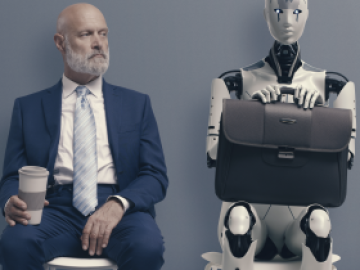As AI's influence continues to grow, business leaders worldwide are recognizing its potential to reshape industries and redefine traditional business paradigms, promising efficiency and innovation on an unprecedented scale.
Yet, with these strides, a deeper consideration with profound implications surfaces among leaders: while this technology can process, predict, and even learn—can it truly lead?
At its core, leadership thrives on the intricacies of innate human emotion, perception, and the ability to connect with others. While AI offers impressive analytical capabilities, it has yet to, and may never, fully replicate the depth of empathy, moral judgment, and interpersonal understanding of human-to-human connection and, therefore, human leadership.
As a result, even in an era dominated by algorithms and digital transformations, the human aspects of leadership and human contribution become even more vital, serving as crucial counterweights to the escalating influence of machines.
Emotional intelligence (EI) and human-centered leadership (HCL) are two related concepts that will play a significant role as we advance, as they are key to ensuring that human contribution remains a valued and integral part of business and industry.
What Are Emotional Intelligence and Human-Centered Leadership?
At its essence, emotional intelligence (EI) refers to one’s capacity to recognize, understand, and manage emotions, both within oneself and in interactions with others. EI is underpinned by self-awareness, self-regulation, motivation, empathy, and social skills.
Human-centered leadership, meanwhile, is a leadership philosophy and approach that prioritizes human values, needs, and potential in decision-making, keeping people at the center of organizational processes. It directly relates to emotional intelligence because it revolves around empathy, ethical clarity, a growth mindset, and adaptability.
In a recent article about HCL, Josh Bersin states, “.... ‘traditional’ leadership is all about performance, profitability, deadlines, projects, status reports, and results. Human-centered leadership, on the other hand, puts people first and makes success happen with people, not despite them”.1
EI and HCL enable leaders to inspire trust, create inclusive environments, and adapt to change. More than ever, as technology redefines boundaries, leaders who embody these attributes foster engagement, creativity, and resilience within their teams.
The Importance of EI & HCL in the Age of AI
In an evolving workplace where algorithms play an increasingly dominant role, there's a tangible threat to human agency. As reflected in the book "Only Humans Need Apply," the omnipresence of such technology can unintentionally push employees to the periphery, leading to feelings of obsolescence and detachment.2
This transition may amplify feelings of alienation and jeopardize employees' motivation, making them feel like mere cogs in a vast machine-driven system.
However, with the conscientious application of human-centered leadership, leaders can create an environment where AI doesn't overshadow our inherent human qualities but instead helps employees feel even more enabled and valued.
In a recent Forbes article3, author Chuen Chuen Yeo suggests a couple of key questions leaders can ask to ensure they remain human-centered. These are:
- What "human needs" do my employees have?
- What am I doing daily to meet their needs of autonomy, sense of belonging, and mastery?
Answering these questions can help illuminate some needs that might otherwise go unnoticed and provide ideas for how to better support the very human needs of your human employees.
More Human than Human?
Beyond just a memorable concept from the 1982 film Blade Runner, this is an evocative idea that captures AI’s profound potential and the possibility of exhibiting qualities and emotions that are more human-like than even we possess.
In tandem with this vision (and probably a lot less terrifying), we might also imagine AI’s potential to enhance our humanity. For example, AI-driven diagnostic tools might allow doctors to shift their energies from the screen to the soul, deepening the bond with their patients and even improving their “bedside manner.”
Similarly, in other communications, AI doesn’t merely streamline processes—it can refine human interaction, making up for our physical, cognitive, and emotional shortcomings and turning routine exchanges and even a tendency for divisiveness into moments of genuine connection, learning, and growth.
The full scope of AI’s impact on our humanity remains an unfolding narrative. But its ultimate significance likely hinges on our present-day choices in engaging with and shaping this technology.
Embracing AI Without Losing the Human Touch
As we’ve come to see, leaders can’t afford to ignore AI; its efficiency, scalability, and predictive prowess offer undeniable competitive advantages. From data-driven insights to automating mundane tasks, AI frees up time, allowing leaders to focus on strategy and relationship-building.
However, these advantages are rendered moot if we neglect genuine engagement. It’s tempting to use the newfound time as an excuse to distance ourselves, turning AI into a barrier rather than a bridge, potentially hindering our capacity for authentic, human-centered leadership.
Additionally, how we employ AI impacts our human workforce and the products and services it creates. Leaders and decision-makers must recognize that integrating human and AI capabilities is critical for businesses seeking long-term success and innovation.
In fact, a study from Accenture found that businesses that focus solely on automating processes with AI could boost their profitability by up to 60%. Those who combine human ingenuity with AI can push that figure to 200%.4
This underscores the benefit of retaining human creativity, emotional intelligence, and ethical judgment. By replacing humans, businesses risk losing these invaluable attributes and the synergistic potential humans and AI can collectively offer.
Therefore, it’s vital for leaders to proactively shape an organizational culture that strikes a balance between technological advancements and human abilities.
Balancing Tech & Human Abilities (and Needs) Through Culture
Here are a few key tactics that can help leaders shape a culture that embraces AI while still maintaining and supporting human-centered leadership.
- Reinforce a Culture Valuing Emotional Intelligence: Businesses can ensure this trait remains embedded in their ethos by celebrating acts of emotional bravery in addition to other EI milestones.
- Implement AI as a Support Tool: Leverage AI to enhance and complement the skills and insights of human team members. View and frame it as a collaborative partner whose main purpose is to amplify employee potential.
- Involve Humans in AI Decision-making: While AI can analyze vast amounts of data and suggest optimal paths, it's the human touch that brings context, nuance, and ethical considerations into the final decision-making process.
- Ensure Transparent and Ethical Use of AI: By establishing clear ethical guidelines, businesses can guarantee that AI implementations are transparent and equitable.
- Focus on Continued Learning and Upskilling: As technology rapidly advances, it's imperative that teams engage in consistent training and upskilling. This ensures that human expertise remains aligned with technological progression.
- Humanize AI Interactions: Crafting AI interfaces that are both intuitive and engaging ensures that AI becomes an enabler rather than an obstacle, enhancing employee experience and collaboration.
Remaining Customer-Focused
In modern business, a holistic emphasis on human-centeredness is indispensable. Beyond human-centered leadership, which prioritizes team cohesion and employee wellbeing, the significance of user-centered product/service design and customer-centric approaches cannot be understated.
AI presents a double-edged sword in this context. It holds the potential to augment these human-centric strategies or erode them if misapplied. The outcome hinges on our approach to harnessing its capabilities.
For instance, AI can revolutionize the way businesses interact with their clientele. It can personalize customer experiences, anticipate their requirements, and provide service with an efficiency that was previously unthinkable. Yet, without a genuine human touch or an understanding of intrinsic human needs, the technology might miss the mark.
Final Considerations
Technology can map patterns, but only a human mind can truly understand another. In this way, successful leadership in this new era rests on one’s ability to join the strengths of AI with the profound depths of human emotion, intuition, and contribution.
Emotional intelligence and human-centered leadership are critical for merging AI and human capabilities in a way that protects human contribution and agency. They are the key to ushering in a future where machines amplify humanity's potential rather than define it. And to ensure that, in the end, the very purpose of leadership remains irrevocably human.
References:
- What is human-centered leadership? Josh Bersin
- Davenport, T. H., & Kirby, J. (2016). Only humans need apply: Winners and losers in the age of smart machines. HarperCollins.
- Why Organizations Need Human-Centered Leaders, And Three Tips To Get Started - Forbes
- Accenture. (2018). Reworking the Revolution. Retrieved from https://www.accenture.com/us-en/insights/future-workforce/reworking-the-revolution.
Dive Deeper
Take a deep-dive into this topic and gain expert, working knowledge by joining us for the programs that inspired it!
Artificial Intelligence: Business Strategies and Applications
Learn about AI’s current capabilities and potential, the reach of automation, machine learning, and robotics.
View details on partner siteVenture Capital Executive Program
Learn how to select and secure VC deals, create a comprehensive investment strategy, and gain a deeper understanding of corporate VC.
Learn moreProduct Management Program
Understand your customer’s needs, design customer products & experiences, and boost your team’s performance for a competitive advantage.
Learn more


